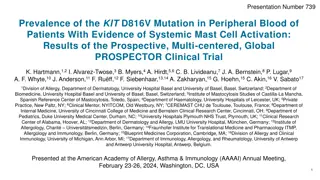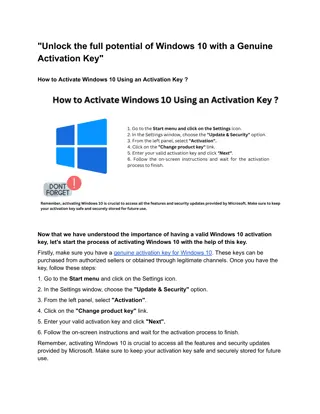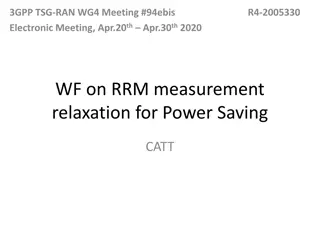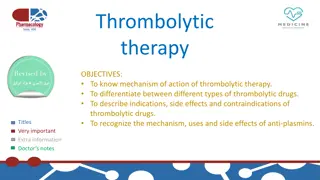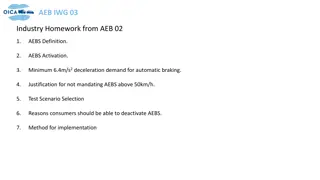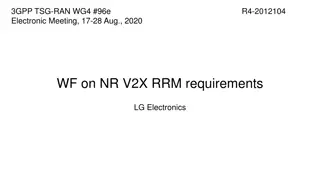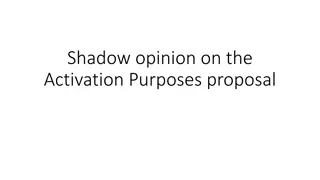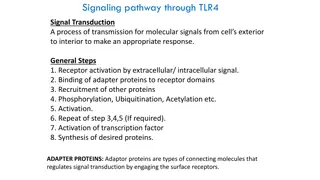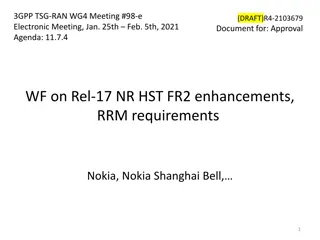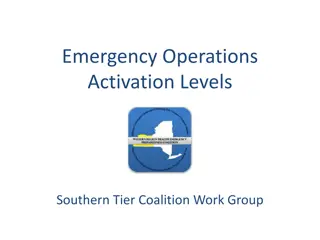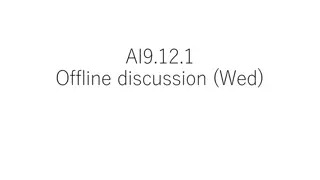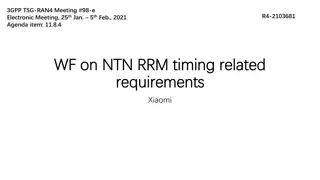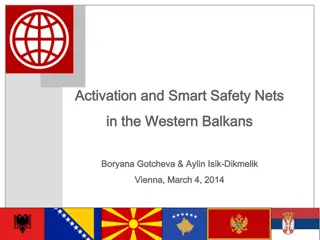RRM Enhancement for NR and MR-DC: PUCCH SCell Activation Requirements
In the electronic meeting of 3GPP TSG-RAN-WG4, the discussions focused on enhancing RRM for NR and MR-DC, specifically addressing PUCCH SCell activation/deactivation requirements. Points were made regarding the ending points of PUCCH SCell activation for both valid and invalid TA cases, beam information necessity for PUCCH SCell activation in different scenarios, and agreements on indicating SSB index to the network for unknown cells in FR1 and FR2 bands.
Download Presentation

Please find below an Image/Link to download the presentation.
The content on the website is provided AS IS for your information and personal use only. It may not be sold, licensed, or shared on other websites without obtaining consent from the author.If you encounter any issues during the download, it is possible that the publisher has removed the file from their server.
You are allowed to download the files provided on this website for personal or commercial use, subject to the condition that they are used lawfully. All files are the property of their respective owners.
The content on the website is provided AS IS for your information and personal use only. It may not be sold, licensed, or shared on other websites without obtaining consent from the author.
E N D
Presentation Transcript
3GPP TSG-RAN WG4 Meeting #99-e Electronic Meeting, 19th 27thMay, 2021 R4-2108345 WF on further RRM enhancement for NR and MR-DC - PUCCH SCell activation/deactivation requirements Agreement in 1stround Agreement in 2ndround CATT
Sub-topic 1-1 Ending point of PUCCH SCell activation Issue 1-1-1: The ending point of PUCCH SCell activation procedure for valid TA case? For valid TA case, the ending point of PUCCH SCell activation should be the point when UE transmit valid CSI report on target PUCCH SCell Issue 1-1-2: The ending point of PUCCH SCell activation procedure for invalid TA case? Option 1: (Qualcomm, Xiaomi, Apple, CMCC, NTT DOCOMO, vivo, MTK, NEC, OPPO, Huawei, Ericsson) For invalid TA case, the ending point of PUCCH SCell activation should be the point when UE transmit valid CSI report on the target PUCCH SCell Option 2: (CATT) For invalid TA case, the ending point of PUCCH SCell activation should be the point when UE transmit PRACH on PUCCH Scell Option 3: (Nokia) For invalid TA case, the ending point of PUCCH SCell activation should be the point when RACH is completed on PUCCH Scell.
Sub-topic 1-2 Beam information for PUCCH SCell activation(1/6) Issue 1-2-1: Whether the beam information (SSB index) of PUCCH SCell is needed to be indicated to NW for unknown cell in FR2? Agreements If the target PUCCH Scell is known, no need to indicate the beam information to network for determining the associated SSB in PDCCH order for RA, i.e., no additional SSB based beam measurement is needed. If the target PUCCH Scell is unknown cell in FR2: If there is at least one active serving cell on that FR2 band (following the same conditions in TS38.133 section 8.3.2 for intra-band FR2 Scell activation), no need to indicate the beam information to network for determining the associated SSB in PDCCH order for RA. Otherwise, need to indicate the beam information to network for determining the associated SSB in PDCCH order for RA. Note: When capturing the agreements in the specification, the text on known and unknown condition shall be aligned with existing SCell activation requirements.
Sub-topic 1-2 Beam information for PUCCH SCell activation(2/6) Issue 1-2-2: Whether the beam information (SSB index) of PUCCH SCell is needed to be indicated to NW for unknown cell in FR1? Agreements: If it is contiguous to an active serving cell in the same band (following the same conditions in TS38.133 section 8.3.2 for intra-band contiguous FR1 Scell activation), no need to indicate the beam information to network for determining the associated SSB in PDCCH order for RA. Otherwise, need to indicate the beam information to network for determining the associated SSB in PDCCH order for RA.
Sub-topic 1-2 Beam information for PUCCH SCell activation(3/6) Issue 1-2-3: How to indicate the beam information for PUCCH SCell activation (The procedure for beam indication for PUCCH SCell activation)? Option 1: (vivo) RAN4 to discuss/decide whether to define the SCell activation requirements for unknown cell (including valid TA case and invalid TA case) Option 1a: (MTK, Apple, Qualcomm(for R15/16 UE), CATT) RAN4 only define requirements for the known cell (include FR1 and FR2) Option 1b: RAN4 define requirements for both known and unknown cell (include FR1 and FR2) Option 2: (Apple, Qualcomm(for R15/16 UE), CATT) Using L3 measurement report of PUCCH SCell via SpCell PUSCH Option 3: (Xiaomi, vivo) UE measures the quality of the PUCCH SCell and reports the beam information to network via SpCell. Option 4: (Xiaomi, MTK, Nokia, vivo, Huawei, Ericsson, Qualcomm(for R17 UE), NEC, NTT DOCOMO, CMCC) Send an LS to RAN1 to confirm the feasibility of beam information indication approach Whether UE can report CSI of PUCCH SCell via SpCell Whether CBRA can be supported on PUCCH SCell for the advantages of facilitating the unknown PUCCH SCell activation with invalid TA. The possibility of unknown PUCCH SCell activation procedure
Sub-topic 1-2 Beam information for PUCCH SCell activation(4/6) Issue 1-2-4: Which cell is the L1-RSRP reporting transmitted for PUCCH SCell activation? Agreements: L1-RSRP report is one kind of CSI report, and the same solution of CSI report in issue 1-2-3 can be applied. Issue 1-2-5: Whether the UL spatial relation is needed for PUCCH Scell activation? Agreements: The UL spatial relation of PUCCH on target being-activated Scell should be considered for PUCCH Scell activation for valid case. The UL spatial relation of PUCCH on target being-activated Scell should be considered for PUCCH Scell activation in FR2 only. the time uncertainty of the MAC CE for UL spatial relation activation of PUCCH in target being- activated Scell shall be defined in the baseline FR2 Scell activation delay part (Tactivate_basic). Details are FFS. FFS: whether the UL spatial relation of PUCCH on target being-activated Scell should be considered for PUCCH Scell activation for invalid case.
Sub-topic 1-2 Beam information for PUCCH SCell activation(5/6) Issue 1-2-5a: Whether the UL spatial relation of PUCCH on target being- activated Scell should be considered for PUCCH Scell activation for invalid case? Option 1: (Xiaomi, vivo, Huawei, Ericsson, Apple, NTT DOCOMO, CATT) Yes Option 2: (MTK, Nokia) No Note: this issue is related to the outcome of issue 1-3.
Sub-topic 1-2 Beam information for PUCCH SCell activation(6/6) New Issue 1-2-6: Whether the beam information (L1-RSRP measurement result) of PUCCH SCell for TCI determination is needed or not for unknown cell? FFS Whether the beam information (L1-RSRP measurement result) of PUCCH SCell for TCI determination is needed or not FFS: whether the beam information is needed to be indicated to NW FFS: for valid TA and invalid TA case FFS: for FR1 and FR2 Note: this issue is related to the outcome of issue 1-2-3.
Sub-topic 1-3 UE capability for PUCCH SCell activation requirements Option 1: (Apple) For UEs not supporting beamCorrespondenceWithoutUL-BeamSweeping, FR2 PUCCH Scell (de)activation requirements are not defined. Option 2: (Ericsson, NTT DOCOMO, vivo) Rel-17 PUCCH SCell activation should require beam correspondence related capability support Option 3: (Qualcomm, Ericsson, NTT DOCOMO, Nokia, vivo, Apple) Current set of requirements is developed for Ues supporting either of following capabilities: beamCorrespondenceWithoutUL-BeamSweeping beamCorrespondenceSSB-based-r16. Option 4: (MTK, CATT, Huawei) FFS
Sub-topic 1-4 PUCCH Scell activation delay requirement for valid TA case Option 1: (CATT, Xiaomi, CMCC, NTT DOCOMO, Nokia, Ericsson) Reuse the Rel-15 SCell activation delay requirement for valid TA case, i.e. (( THARQ+ Tactivation_time+TCSI_Reporting)/ NR slot length). Option 2: (Apple, MTK, Qualcomm, OPPO, vivo) In FR1, reuse the Rel-15 SCell activation delay requirement which is (( THARQ+ Tactivation_time+TCSI_Reporting)/ NR slot length). In FR2, use normal SCell activation delay (i.e., (( THARQ+ Tactivation_time+TCSI_Reporting)/ NR slot length);) in TS38.133 section 8.3.2 as baseline, but the time uncertainty of the MAC CE for UL spatial relation activation of PUCCH in target being-activated SCell shall be considered in the baseline Tactivation_time. Option 3: (NEC) PUCCH SCell activation delay (TDelay_PUCCH_SCell) is defined as: TDelay_PUCCH_SCell=TBasic_SCell_activation_delay+ TL1-RSRP+ TTA_delay+ TUL_spatial_relationInfo; where: TBasic_SCell_activation_delayis SCell activation delay as described in clause 8.3.2 of TS 38.133; TL1-RSRP: L1-RSRP measuring and reporting delay. This is zero for FR1/2 known SCells and FR2 unknown SCells; TTA_delay: Delay required for TA command acquisition and application. Exact delay is FFS; and TUL_spatial_relationInfo: Delay uncertainty for receiving UL spatial relation info MAC CE and UL spatial relation info application delay. Exact delay is FFS. This is applicable only when CSI report of to be activated SCell is transmitted on SCell. TTA_delayis considered to be zero.
Sub-topic 1-5 PUCCH Scell activation delay requirement for invalid TA case(1/3) Issue 1-5-1: The PUCCH SCell activation requirements for invalid TA case Option 1: (CATT) The PUCCH SCell activation requirements for invalid TA case is: Delay = (( THARQ+ Tactivation_time+ TCell_search+ TCSI_Reporting+ TSSB index+ TPDCCH+ T1)/ NR slot length) TCell_search= 0 if PUCCH SCell is known. TSSB index= 0 if PUCCH SCell is known or ssb-PositionInBurst indicates only one SSB. Option 2: (Xiaomi, Apple, CMCC, NTT DOCOMO, vivo, MTK, OPPO, Ericsson) If UE does not have the valid TA on the PUCCH SCell being activated, an additional UL synchronization procedure to obtain the valid TA shall be considered which including the following factors: the delay uncertainty in acquiring the first available PRACH occasion in the PUCCH Scell(T1); the delay for obtaining a valid TA command for the sTAG to which the SCell configured with PUCCH belongs(T2); the delay for applying the received TA for uplink transmission(T3) Option 3: (Nokia) The activation delay shall be discussed for downlink and uplink actions separately. THARQ+Tactivation_time NR slot length The UE shall be capable to perform downlink actions related to the SCell activation command for the SCell being activated on the PUCCH SCell no later than in slot n + . The activation delay requirement for PUCCH SCell shall be defined assuming no dedicated time period for CSI measurements and reporting. The UE shall be capable to perform uplink actions related to the SCell activation command for the SCell being activated on the PUCCH SCell no later than in slot n + THARQ+Tactivation_time+TRACH NR slot length , where TRACH is the delay to perform RACH procedure and apply the TA. In case beam information needs to be transmitted, the CSI report may be sent together with the beam information hence RACH completion can be considered as the ending point of PUCCH SCell activation. Option 4: (NEC) PUCCH SCell activation delay (TDelay_PUCCH_SCell) is defined as: TDelay_PUCCH_SCell=TBasic_SCell_activation_delay+ TL1-RSRP+ TTA_delay+ TUL_spatial_relationInfo; where: TBasic_SCell_activation_delayis SCell activation delay as described in clause 8.3.2 of TS 38.133; TL1-RSRP: L1-RSRP measuring and reporting delay. This is zero for FR1/2 known SCells and FR2 unknown SCells; TTA_delay: Delay required for TA command acquisition and application. Exact delay is FFS; and TUL_spatial_relationInfo: Delay uncertainty for receiving UL spatial relation info MAC CE and UL spatial relation info application delay. Exact delay is FFS. This is applicable only when CSI report of to be activated SCell is transmitted on SCell. TTA_delayis T1+T2+T3
Sub-topic 1-5 PUCCH Scell activation delay requirement for invalid TA case(2/3) Issue 1-5-1a: Whether to define separated requirements for downlink actions and uplink actions? Option 1: (Nokia, Ericsson, CMCC) Yes Option 2: (Xiaomi, Apple, vivo, Huawei) No Option 3: (MTK, Qualcomm, NEC, NTT DOCOMO, CATT) FFS Issue 1-5-2: the delay uncertainty in acquiring the first available PRACH occasion in the PUCCH SCell (i.e. T1) Agreements: T1 is up to the summation of SSB to PRACH occasion association period and 10 ms. SSB to PRACH occasion associated period is defined in the table 8.1-1 of TS 38.213
Sub-topic 1-5 PUCCH Scell activation delay requirement for invalid TA case(3/3) Issue 1-5-3: the delay for obtaining a valid TA command for the sTAG to which the SCell configured with PUCCH belongs (i.e. T2) Option 1: (CATT) T2 should not be considered in the delay requirements for PUCCH SCell activation Option 2: (vivo, MTK, Apple, Qualcomm, Ericsson, OPPO, Huawei, NEC, NTT DOCOMO) T2is the delay from slot n + (Tactivate_basic+T1)/NR slot length until UE has obtained a valid TA command for the target PUCCH SCell being activated. Tactivate_basicis the normal SCell activation delay in TS38.133 section 8.3.2. slot n is the slot when UE received PUCCH SCell activation MAC CE Option 3: (Nokia) FFS Issue 1-5-4: the delay for applying the received TA for uplink transmission on target PUCCH SCell being activated (i.e. T3) Option 1: (CATT) T3 should not be considered in the delay requirements for PUCCH SCell activation Option 2: (vivo, MTK, Apple, Qualcomm, Ericsson, OPPO, Huawei, NEC, NTT DOCOMO) T3is the delay for applying the received TA for uplink transmission on target PUCCH SCell being activated, and greater than or equal to k+1 slot, where k is defined in clause 4.2 in TS 38.213.
Sub-topic 1-6 Interruption requirements for PUCCH SCell activation in invalide TA case Option 1: (CATT, Ericsson, NEC, Nokia) Reuse the interruption requirement of normal Scell activation Option 2: (MTK, Apple, Qualcomm, OPPO) The interruption requirement shall include the existing requirement for Scell activation in Rel-15. Introduce additional interruption by PRACH transmission when target PUCCH SCell RACH has different SCS from spCell data/control channel and UE does not support diffNumerologyAcrossPUCCH-Group.
Sub-topic 1-7 Applicability of PUCCH SCell activation requirements Option 1: (CATT, Apple) The PUCCH Scell activation delay requirement shall apply provided that, The UE has received a PDCCH order to initiate RA procedure on the PUCCH Scell within Tactivate_basicotherwise additional delay to activate the Scell is expected; and No interruption occurs in same FR as the target PUCCH Scell during the Scell activation procedure if UE supports per-FR MG, otherwise the PUCCH Scell activation delay can be extended, and No interruption occurs during the Scell activation procedure if UE does not support per-FR MG, otherwise the PUCCH Scell activation delay can be extended. The above interruption is caused by factor defined in TS38.133 section 8.2.1.1 for EN-DC, in TS38.133 section 8.2.2.1 for NR SA, in TS38.133 section 8.2.3.1 for NE-DC and in TS38.133 section 8.2.4.1 for NR-DC. Option 2: (Ericsson) For the applicability of PUCCH SCell activation requirements Delay requirements for PUCCH SCell activation shall account for additional time when PDCCH order is received outside Tactivate_basic. The additional time shall be accounted for by an expression and/or a delay component, e.g. max(Tactivate_basic, TPDCCH_order). In activation of multiple SCells with one PUCCH SCell, activation delay requirement shall apply at least for the PUCCH SCell in the event that one or more SCells have configurations that render parallel activation impossible for the UE. FFS on whether activation delay requirement also is to apply for SCells that are compatible with parallel activation with PUCCH SCell. Option 3: (Qualcomm) RAN4 to discuss/determine whether the following cases are valid and/or to be considered for PUCCH Scell (de)activation requirements. Single-TAG vs. Multi-TAG for Dual PUCCH Intra- vs. Inter-band between PUCCH cells


